2017 - Panama Canal Cruise
Note: TIMDT and Mwah (sic) cruising south on the eastern Pacific Ocean towards the Panama Canal. Four weeks and four days post surgery (Bishop) to repair a tibial plateau fracture suffered in a motorcycle incident on 08 August 2017 near Buena Vista, CO. Regent Seven Seas Mariner.

Above: Wheel Chairs in Compass Rose Restaurant, Regent Seven Seas Mariner. 16 September 2017.
Bishop is not the only invalid on this ship! Most "impaired" are men being pushed/squired around by their spouses. I'm guessing there are 12 to 15 in this "requiring assistance" category (I've seen only one woman in a chair) on this ship.
We (TIMDT, SpaGo, Montage and Mwah [sic]), discussed possible reasons for the predominance of men, and not women, in the invalid category. Reasons given were: 1. Shorter life span of men relative to women ergo. men start to deteriorate before their wives. 2. In most marriages, men are older than women. This amplifies reason #1. 3. Men are less likely/prone/able to be care givers. 4. Women/wives, are more eager to keep their husbands vital by being out and about, than are men vis a vis their wives.
On the Regent Seven Seas Voyager cruise in April of this year, from Bangkok to Abu Dhabi, I rolled my eyeballs a few times when witnessing slow poke, "impaired" passengers. "Why don't they stay home?," I might have selfishly and thoughtlessly mused. Now that the shoe is on the other foot, I celebrate these people for reaching beyond their infirmities to obtain new levels of enjoyment.
Lottsa Sea Days
From San Francisco we've been out cruising south for six days and have had only one stop: Cabo San Lucas, Baja California, Mexico.
We were due to make a call on Acapulco, but were thwarted in this because of having to sail, west, around category 1 Hurricane Max. Max hit Acapulco the day we went by and did a fair amount of damage.
It is interesting how US centric American media coverage is ( or so it seems to me) relative to weather conditions around the globe. While the US has experienced hurricanes Harvey and Irma, there have been two or three Pacific storms strike Mexico. Mumbai is inundated because of greater than normal monsoon rains.
Next stop, tomorrow, is Port of San Jose, Guatamala. I don't plan on getting off the ship. TIMDT and SpaGo have reservations to go visit a Guatamalan colonial town.

Above: Panama Canal. File image. 16 September 2017.
(note: not at Canal yet.... but, reading up before arrival).
Great.
New, larger, canal locks suffused with poor workmanship, engineering flaws, and unwanted porous concrete.
Overall builder incompetence. Spanish led consortium, which notwithstanding their questionable work, is asking for $5 billion of cost overruns from the Panama Canal Authority.
Wonder who got rich off of this one?
Maybe we should turn the Regent Seven Seas Mariner around?
https://www.nytimes.com/interactive/2016/06/22/world/americas/panama-canal.html?smid=fb-share
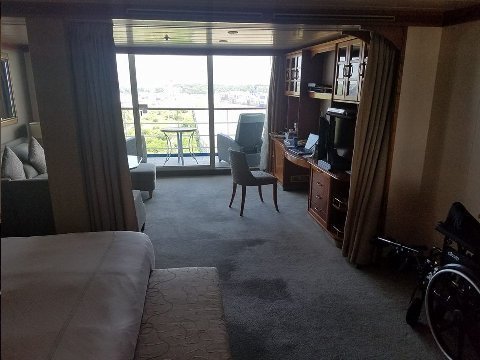
Above: Our cabin. Regent Seven Seas Mariner. Docked at Puerto Quetzal, Guatemala. 16 September 2017.
Bishop holds down the fort in the cabin as TIMDT joins SpaGo on a tour excursion to Antigua, Guatemala.
Out this port window is the only part of Guatemala I'll see.... on this trip.
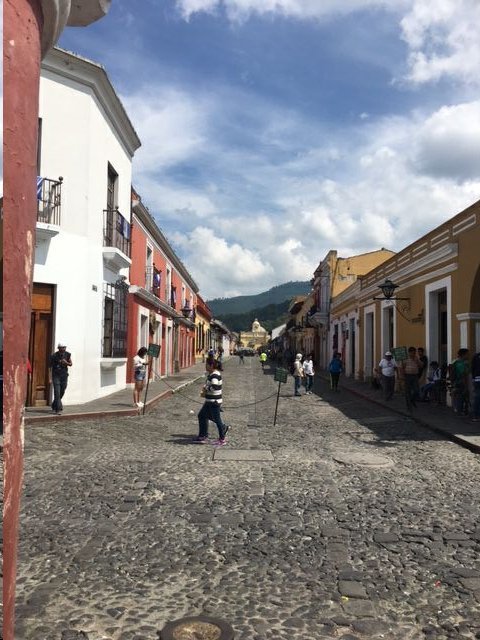
Above: Antigua, Guatemala. 16 September 2017. Image by TIMDT.
The city is in the central highlands of Guatemala. It is known for its well-preserved Spanish Baroque-influenced architecture as well as a number of ruins of colonial churches. It served as the capital of the Kingdom of Guatemala. It has been designated a UNESCO World Heritage Site.
Gimpy legged Bishop was unable to join SpaGo and TIMDT on this excursion. Just as the Bishop channeled his kids' families' early August 2017 Riverton, WY visits to see the total eclipse, he also channeled the Antigua visit through the reports of TIMDT and SpaGo.
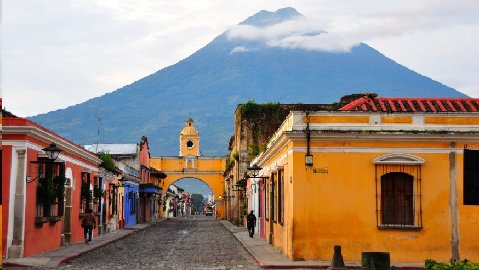
Above: Beyond Antigua, Guatemala: Volcan di Agua. File image. 16 September 2017.
Volcan di Agua rises over six thousand feet above the elevation of Antigua and has a total elevation of about 11 thousand feet. It has a climbing path for those with the time to do it.
Guatemala's central cordillera has a couple of dozen volcanoes, several of which are still active. The highest of the volcanoes clear 12K feet.
Guatemala is ground zero for the Mayan Civilization which died out (as a great civilization) around 900 AD, purportedly due to climate change (drought).
TIMDT and Mwah (sic) have a friend who started a foundation in Guatemala to provide native peoples, used to using brush and fire wood for open cooking fires, with stoves. The stoves conserve fuel and reduce deforestation as the population grows.
Guatemala is the most populous country in Central America with 16 million souls. Panama, by contrast, has four million people.
TIMDT reported seeing a number of American women, in lacy clothing, working in some of the stores. According to her guide, she said, there are quite a few American families living in retirement in Antigua.
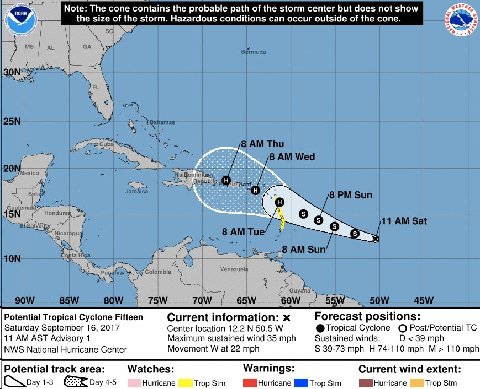
Above: Tropical Depression 15 in the eastern Caribbean Ocean. 16 September 2017.
Storm will be named "Maria" if and when it becomes a Tropical Storm. It appears to be headed on a similar path to Irma which devastated Florida a few days ago.
A lot of storm activity in the Caribbean and the Atlantic probably has the captain of the Regent Seven Seas Mariner, and his crew, on their toes as, after passing through the Panama Canal, they must negotiate a pathway to New York City through this storm riddled area.
Addendum:
Craig, my race mechanic, says he can put a small block Chevy
on the back of your wheelchair to help out TIMDT on the hills……
The Commodore,
Park City, UT
What a great blog! Love to you and to Margaret!
ZIB
New York City, NY
Sounds like a great way to recover. I got another Coritzone treatment for my hip - the reason I was not riding in the Big Dog. This one seems to be working. I am reading Elisapeth Beard's book Lone Rider about a MC trip round the world. Seems good but I only started. I also have been watching DVD's of a British drama called Foyle's War. Fantastic if you can find em. Got mine in the library.
Burning Man,
Reno, NV
Thanks for the book recommendations. I've seen a dozen episodes of Foyle's War. Second your recommendation.
Great entertaining book. Glad cruise is going well. I thought it made sense to go. Just arrived in nyc and it is booming w traffic and construction. Enjoy yourself.
Comic Mom,
New York City, NY

Above: FeeBee and Bud. Park City Balloon Festival. 16 September 2017.

Above: Rambutan lady and TIMDT. Leon, Nicarauga. 17 September 2017.
Image by SpaGo.
SpaGo, Montage, and TIMDT went on a shore excursion to Nicaragua's second largest city, Leon.
The Regent Seven Seas Voyager docked at Nicaragua's principal Pacific Ocean port, Peurto Corinto.
Top of mind while here in Nicaragua are Iran Contra and a new canal.
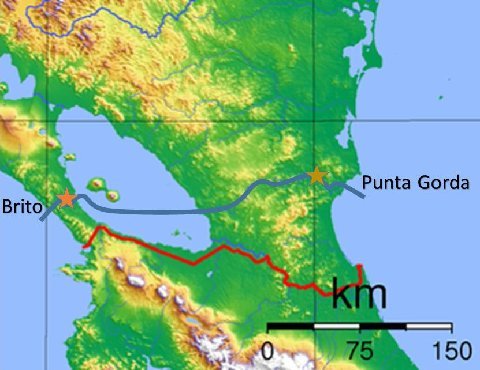
Nicaragua Notes:
The Iran–Contra affair (Persian: ماجراي ایران-کنترا, Spanish: caso Irán-Contra), also referred to as Irangate,[1] Contragate[2] or the Iran–Contra scandal, was a political scandal in the United States that occurred during the second term of the Reagan Administration. Senior administration officials secretly facilitated the sale of arms to Iran, which was the subject of an arms embargo.[3] They hoped, thereby, to fund the Contras in Nicaragua while at the same time negotiating the release of several U.S.hostages. Under the Boland Amendment, further funding of the Contras by the government had been prohibited by Congress.
The scandal began as an operation to free seven American hostages being held in Lebanon by Hezbollah, a paramilitary group with Iranian ties connected to the Army of the Guardians of the Islamic Revolution. It was planned that Israel would ship weapons to Iran, and then the United States would resupply Israel and receive the Israeli payment. The Iranian recipients promised to do everything in their power to achieve the release of the hostages.[4][5] Large modifications to the plan were devised by Lieutenant Colonel Oliver North of the National Security Council in late 1985, in which a portion of the proceeds from the weapon sales was diverted to fund anti-Sandinista, or Contras, in Nicaragua.[4] Wikipedia
The Nicaraguan Canal (Spanish: Canal de Nicaragua), formally the Nicaraguan Canal and Development Project (also referred to as the Nicaragua Grand Canal, or the Grand Interoceanic Canal) is a planned shipping route through Nicaragua to connect the Caribbean Sea (and therefore the Atlantic Ocean) with the Pacific Ocean. Its viability has been questioned by shipping experts and engineers.[1] "Major works" such as dredging will take place after the finishing of a Pacific Ocean wharf, whose construction was planned to start in late 2016.[1]
In June 2013, Nicaragua's National Assembly approved a bill to grant a 50-year concession to finance and manage the project to the private Hong Kong Nicaragua Canal Development Investment Company (HKND Group) headed by Wang Jing, a Chinese billionaire.[2][3][4][5][6][7] The concession can be extended for another 50 years once the waterway is operational.[8] Media reports have suggested the project would now be delayed or even possibly canceled because Wang's personal wealth declined greatly as a result of the 2015–16 Chinese stock market crash.[1][9] The Nicaraguan government has failed to present reliable information about whether or not the project can be financed, thus casting doubt over whether or not it can be completed.[10][11][12][13] The HKND Group says that financing will come from debt and equity sales and a potential initial public offering (IPO).[1] Wikipedia
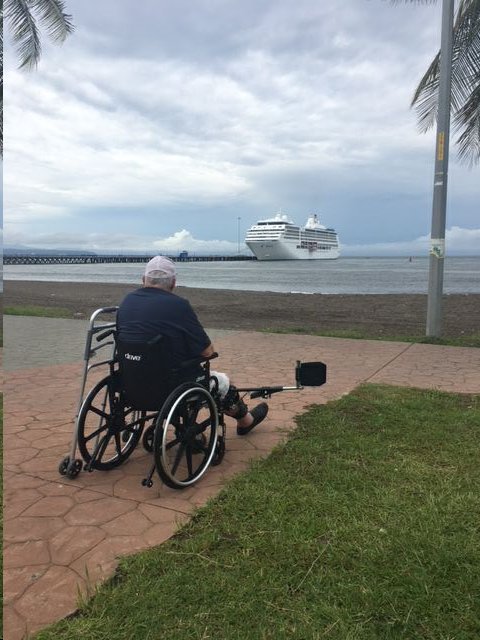
Above: Bishop gazes at Regent Seven Seas Voyager. Puntarenas, Costa Rica. 18 September 2017.
Hat tip to TIMDT who suggested Bishop's first outing off the ship since leaving San Francisco over a week ago. TIMDT pushed the Bishop's wheel chair to this point and back to the ship.
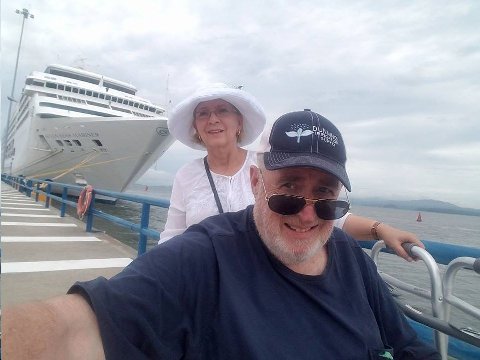
Above: TIMDT, Bishop and Regent Seven Seas Mariner. Puntarenas, Costa Rica. 17 September 2017.
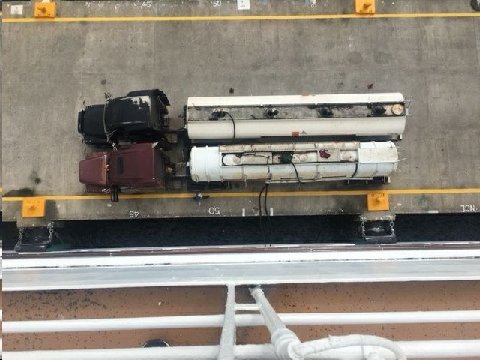
Above: Refueling Regent Seven Seas Mariner. Puntarenas, Costa Rica. 17 September 2017.
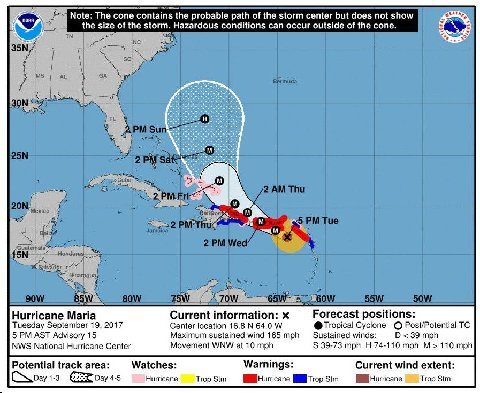
Above: Cone Projection of Hurricane Maria. 19 September 2017.
Regent Seven Seas Mariner exiting Panama Canal into Caribbean Sea tomorrow afternoon. First a one day stop at Cartagena, then head north in what looks to be the wake of the storm. No doubt our captain will keep us safe, even if it requires some unforeseen routing. But, pray for Puerto Rico, which does not have the luxury of mobility
Addendum:
Brings back memories. Phil and I took a similar trip on the Regent Mariner a couple yrs ago except we left Miami and ended up in LA and flew back. We also stopped in Guatemala (I am sure the same tour). Hope you are healing well and enjoying the cruise.
Bridge,
Palm Beach, FL
Are you going to get your blue ADA parking rear view mirror card? You could raise a few eyebrows in the ski slope parking lot with it.
Nathans,
Massapequa, NY
TIMDT got one for us. Seeing this oft abused practice in a new light. It helps.
Clock is ticking, so soon you should be kicking! Just over a month now since your get-off and subsequent leg bone patch (likened to an inner tube patch) and your bones should be knitting.
Your reportage on being in Antigua reminded me of my week-long stop there in 1997 on my way to the southern tip of South America on a well-worn 1981 R80G/S. I'd realized the limited Tex-Mex Spanish I had one my cranial hard drive was inadequate for smooth road adventures ahead, so spent the days during the week learning proper Spanish, nights being tutored by a local native on how to sniff out and survive nocturnal pursuits, the later best not described on a published forum such as this. Upon leaving Antigua I was well enough armed in Spanish and common sense to manage the rest of Latin and South America on my on, later described in my book RIDING SOUTH, and some in DOWN AND OUT..... 20 years later I suspect Antigua has morphed into a far different urban environment, one which can accommodate a busted leg Gringo hobbling around versus a well-beered Gringo stumbling around (but also suspect the rounded protruding cobblestones on some streets still remain an adventure on two good legs).
Soldier on. I look forward to our next meeting when we can walk, or stop while driving motorcycles, and talk about our "Whenwes," as in "When we" had our busted legs.
Regards,
Dr. G
Chief, World Adventure Affairs Desk, CITY BIKE Magazine
Crow Agency, MT
Project Director - THE LOST MAN
Steve
Seeing the pictures of the streets of Guatemala reminds me of taking my son to Rome. Like Guatemala, the streets of Rome are often cobbled and moving a wheelchair over cobbles is a massive challenge both physically and due to all the ruts. Rome did teach me a new technique in dealing with rough streets and sidewalks. You pull the wheelchair backwards. The wheelchair and the occupant have the view of what is behind you while your arms are stretched back as you lean forward and pull the chair. The large back wheels that are fixed go over the cobbles and because you are going backwards the small front wheels are pulled over the cobbles and do not get caught in them.
The other advantage of helping someone in a wheelchair is that you get special access to the Vatican. You also see more of the Vatican than the normal visitor because you need elevators to get around inside. Most of the elevators are behind the barriers that contain the average tourist. I was helped by Vatican staff who would escort me to an elevator showing me the sights along the way. I also found within the Vatican, people including tourists were much more polite than normal. I guess they did have the "Fear of God".
That said, given the slight differences in size between you and Margaret, I understand why you were abandoned on ship in Guatemala. I am not sure whether cobbled streets or snow in a ski resort is tougher on the wheelchair dragger.
All the best for a very speedy and complete recovery.
The Pope,
Naples, FL
I spent a lot of time in Guatemala in the mid 80s. There was some serious crime then but as I learned recently from a man whose son is a mission president there it is now a disaster. Would like your views on what you heard regarding crime? Glad you are having fun as a handicapped person!
The Monk,
Salina, UT
Is there someplace in the world where you haven't spent a lot of time?
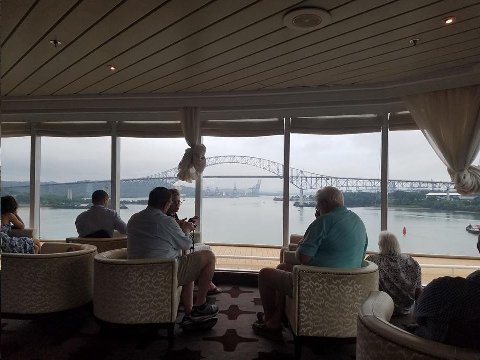
Above: Bridge of the Americas. Panama Canal. 20 September 2017.
Image taken from Observation Lounge. Regent Seven Seas Mariner.
The ship took on the pilot about 5:30 AM. I reached the lounge at 6:00 AM, getting up their, hopping with the aid of the walker, on my own power. The whole trip took about 125 hops... down the companionway, into the elevator vestibule, up the elevator, one floor, then into the lounge.
I was surprised to see so many people already in the lounge. But, I found a pretty good seat. TIMDT joined me at 7:00 AM. We stayed in the lounge for over three hours as we passed through the Miraflores Locks and the Pedro Miguel Locks.
My excitement was palpable as the Bridge of the Americas emerged from the morning mists.
Here I was about to enter what many consider to be the greatest engineering accomplishment in history.
Completed in 1914, on the eve of WWI, the canal took eleven years to build. The French had tried, in the same location, to build a canal twenty years previously, but failed largely due to tropical diseases decimating their work force. 20K people died in the French attempt to build the Panama Canal.
Goaded and prodded by US President Teddy Roosevelt, in 1903, American interests purchased the canal rights from the French on the cheap and then petitioned the Panamanians for permission to resume the massive building project.
The Panamanians were OK with going ahead, but, then, they were part of a Columbian federation and the Columbians voted down the American offer.
Not taking no for an answer, the Americans supported (engineered?) a successful Panamanian independence movement, even sending warships to Panama to thwart Columbian troop movements north.
The US negotiated a bullet proof treaty with Panama which ceded the Americans, in perpetuity, with sovereign rights to land ten miles on either side of the length of the entire canal. This area became known as the Panama Canal Zone.
The Panamanian isthmus was too high and rocky for the original French and later American builders to clear a sea-level passage like the Suez Canal, so ships have to be lifted 85 feet from the Pacific to enter the lake midway through the canal, and lowered again on the Atlantic side.
Learning from the failed French attempt to build the canal, the American Army Corps of Engineers managed to control the spread of disease among contract workers of whom almost 20K came from Barbados. US engineers built a railway, imported giant steam shovels and moved mountains to complete an engineering wonder of the world.
The canal opened for business in 1914. By 2011, one million ships had passed through the canal.
In 1977, US president Jimmy Carter negotiated a treaty with President Torrejos of Panama to cede all canal rights to Panama by 1999.
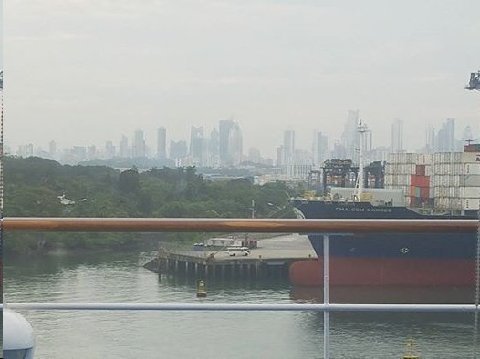
Above: Panama City, Panama. 20 September 2017.
The Panama Canal generates annual revenues of $1.2 billion. The canal buttresses a robust service economy, including financial services and ship servicing. Panama GDP is about $50 billion.
Last year, a ten year project designed to double the canal's capacity - and revenue - was completed. New locks were installed that can handle Panamax container ships.
The original project was budgeted at $5 billion. The Spanish led contractor consortium went over budget by double that and financial claims being made by the contractor against the Panama Canal Authority (PCA) are currently in arbitration.
There are concerns, also, about the overall quality of the construction. The PCA claims that porous concrete used by the contractor is already deteriorating.
Tug operators complain that the new tugs purchased to handle the big Panamax ships are flawed. The tug operators say they only work effectively in reverse.
Throughput in the new locks is well below capacity as canal operators find themselves on a steep learning curve to master techniques to handle the much bigger ships.
While the PCA claims that they will make the new canal work, there appear to be many "ifs" about their ability to realize original expectations.
The US and China are the top users of the Canal. In 2014, Panama completed a metro system in Panama City, valued at $1.2 billion. Strong economic performance has not translated into broadly shared prosperity, as Panama has the second worst income distribution in Latin America. About one-fourth of the population lives in poverty; however, from 2006 to 2012 poverty was reduced by 10 percentage points.
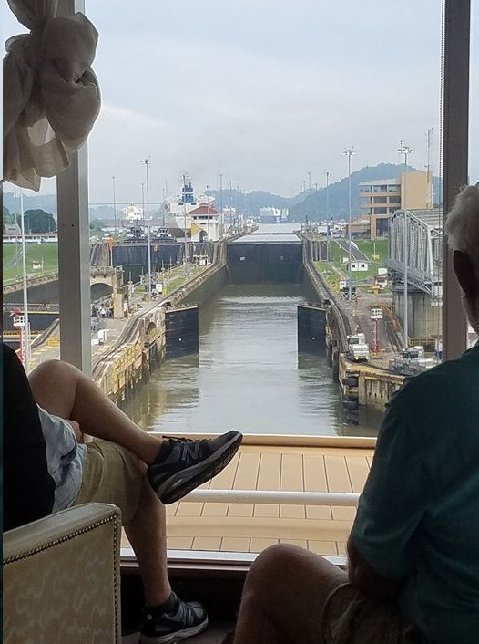
Above: Miraflores Locks. Panama Canal. 20 September 2017.
Image taken by Bishop from observation lounge of Regent Seven Seas Mariner.
Coming from the Pacific, we must go through two sets of locks, one (Miraflores) with two 27 foot raises, and the other (Pedro Miguel), one mile further, with one 27 foot rise.
After passing through the two sets of locks, our ship will pass through the Calebra Cut and cross Gabun Lake to the Gabun Locks.
At Gabun Locks, in three successive locks we'll be lowered back down to sea level eight miles away by canal from the Caribbean Sea.
Total distance: 50 miles. Time of passage: Eight to ten hours.
The locks are filled by gravity. The only power required is for the "mules" which pull and stabilize the ships when they are in the locks and for electric power to open and close the lock gates.
For the canal to be able to operate at full capacity, there must be enough water to accommodate the draft of the large ships. During occasional drought conditions, the lowering lake reduces the draft space and some boats are unable to make it through the canal. Under such drought conditions, the PCA authority advises shippers to lighten loads.
During the last two years there has been plenty of rain and the ships passing through the canal are able to do so at full load capacity.
Dredging, to alleviate draft problems, goes on constantly. Charges are buried into the mud at the base of the canal. The exploding charges create loose mud at the canal bottom which is then removed by dredging equipment.
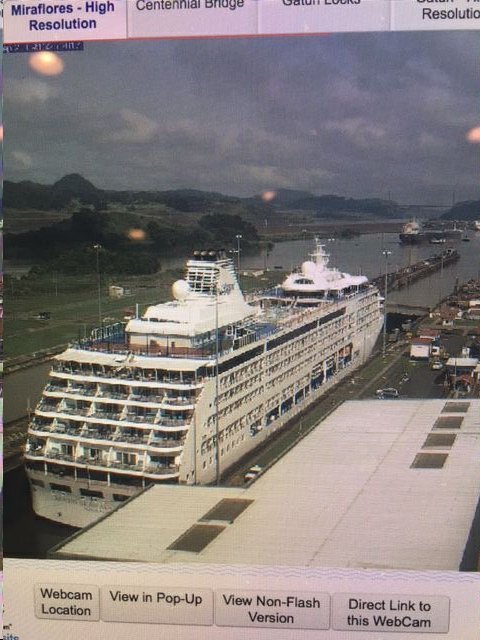
Above: Regent Seven Seas Mariner in Miraflores Locks. 20 September 2017.
Image was captured by Portland, our daughter in law, from the PCA website video cam at the time of the ship's passage.
TIMDT and Mwah (sic) are sitting in the forward top deck observation lounge at the time this image was captured.
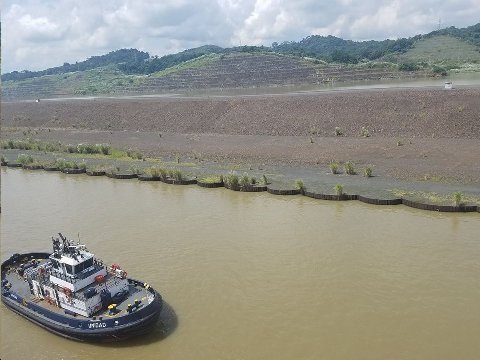
Above: Tug. Nearing Pedro Miguel Locks. Panama Canal. 20 September 2017.
Beyond tug, note higher water level of the new Panamax waterway inaugurated last year.
Pacific to Caribbean bound Panamax ships (read humongous 1000 container ships, fare $1MM per passage), are raised to the level of Gatun Lake at new Miraflores Locks, part of the Panama Canal Expansion Program, inaugurated in 2016.
Our ship, N 21 Zulu, was only raised 2/3 of the way to Gatun Lake level while passing through Miraflores Locks. Hence, our need to get up the third level at upcoming Pedro Miguel Locks about a mile a way through the small Miraflores lake.
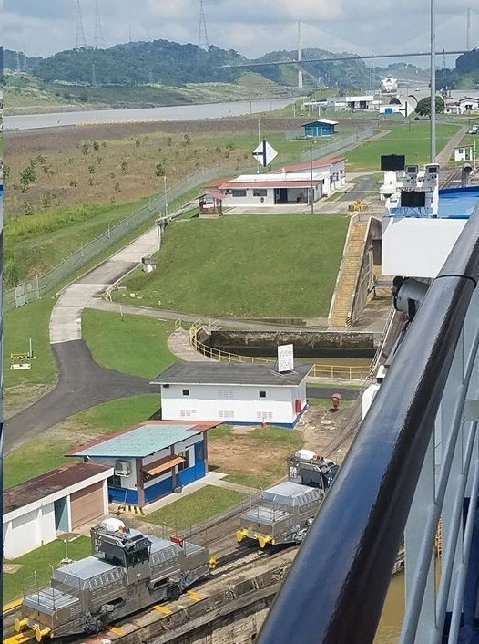
Above: Pedro Miguel Locks. Panama Canal. 20 September 2017.
From our 11th deck cabin deck.
Gatun Lake level Panamax ship passage at left. Pedro Miguel Locks will take us up 27 feet to Panamax passage/Gatun Lake level, a high level for Panama Canal of over 80 feet above sea level.
Note "mules" lower left. Six of these 300 hp tractors, three on each side, will pull N 21 Zulu, our ship, through the lock.
Centennial bridge, beyond, after which, not seen in image, Culebra Cut and Gatun Lake.
Note also port bridge extension (blue floor), one deck below us, forward.
Hard to get a grip on the fact that from the Pacific to the Caribbean, the Panama Canal goes from southeast to northwest!
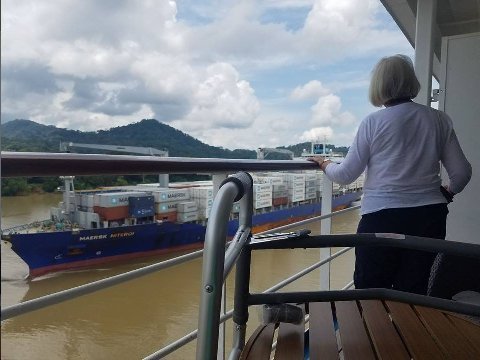
Above: TIMDT observes ship moving opposite direction, Gatun Lake. Panama Canal. 20 September 2017.
Image captured from our 11th deck cabin balcony. Regent Seven Seas Mariner.
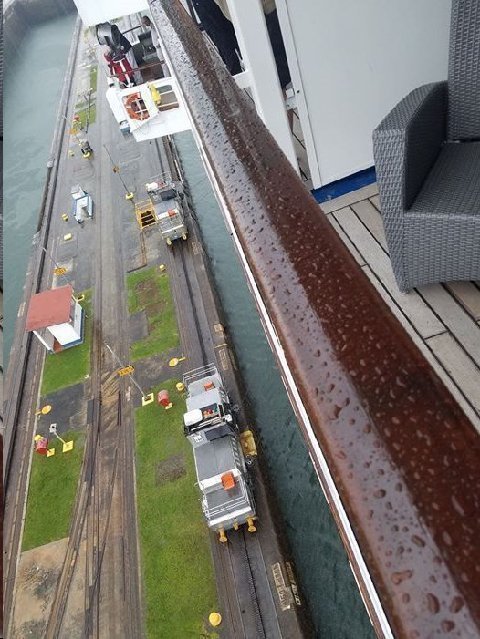
Above: Gatun Locks. Panama Canal. 20 September 2017.
Mules pulling and stabilizing ship.
Three chambers...27 foot lowering, each chamber.
On our way out to Caribbean Sea. — at Gatun Locks Panama Canal.
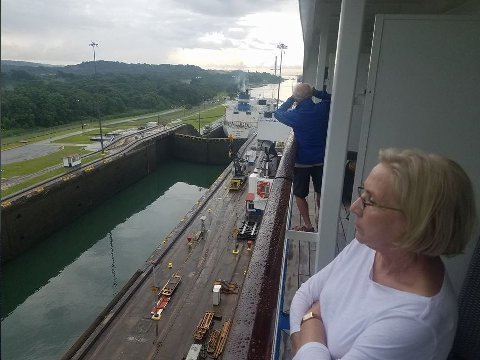
Above: Montage (on adjacent forward deck) and TIMDT. Gatun Locks. Panama Canal. 20 September 2017.
N 21 Zulu is in second of three Gatun lock chambers.
One more chamber, 27 foot drop, before we reach sea level.
Ship beyond is in parallel channel, next lock, going in same direction.
Then....Caribbean Sea and on to Cartagena. — at Gatun Locks Panama Canal.
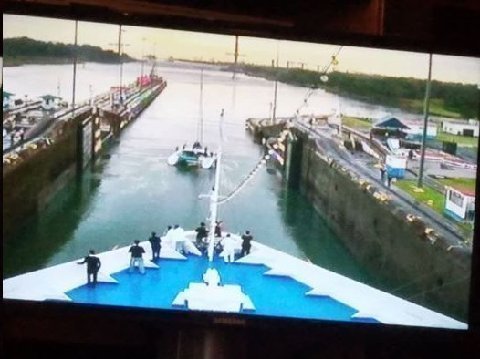
Above: Gatun Locks. Panama Canal. 20 September 2017.
Regent Seven Seas Mariner.
Ship's closed circuit TV in our cabin.
Leaving last Gatun lock at sea level.
Note the catamaran which was in the lock with us.
Now, eight mile long channel to Caribbean Sea. — at Gatun Locks Panama Canal.
I was awe struck for the entire day of passing through the Panama Canal. As we passed through the Panama Canal, I tried, and failed, to comprehend the capacity and vision of the planners of this great engineering accomplishment.
Panama Canal Chief Engineer was John Frank Stevens.
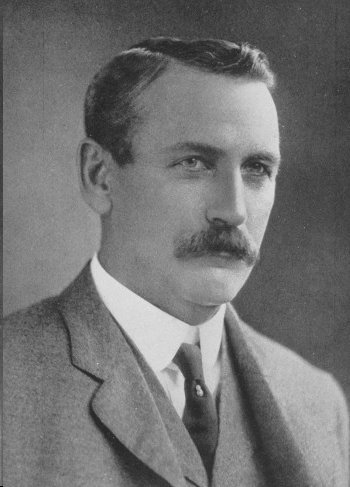
Above: John Frank Stevens. Chief Engineer, Panama Canal construction.
How is it that Stevens is not venerated as a hero of some sorts? Why have the names the great engineers who have established the framework for modern society not been brought top of mind to those of us who have benefited from their creations?
I was reminded of other great engineering sites that I had recently seen.
In 2010 I rode a motorcycle from Anchorage to Prudhoe Bay and back. For much of that route, along "the Haul Road," we followed the Alaska Pipeline, another great engineering accomplishment.
I remember reading a story board at the BLM exhibit at the Yukon crossing of the Haul Road. There was a weathered description of the chief engineer of the Alaska Pipeline, whose name was Edward L. Patton. If I mentioned the name of Ed Patten to one thousand Americans, none would be able to identify him.
Last October, Hoops and I visited the New York Subway Museum in Brookyn, NY. Another great engineering story.
It rankles that our society, driven by modern media, seems to celebrate the trivial and ignore the substantial... like the engineers who realized these great projects.
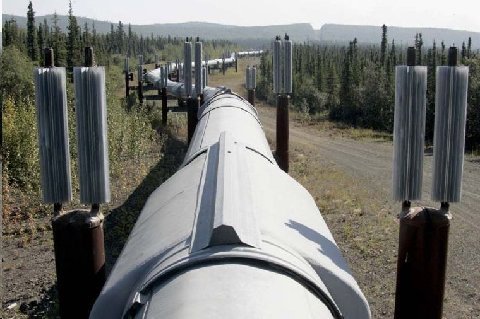
Above: Trans Alaska Pipeline.
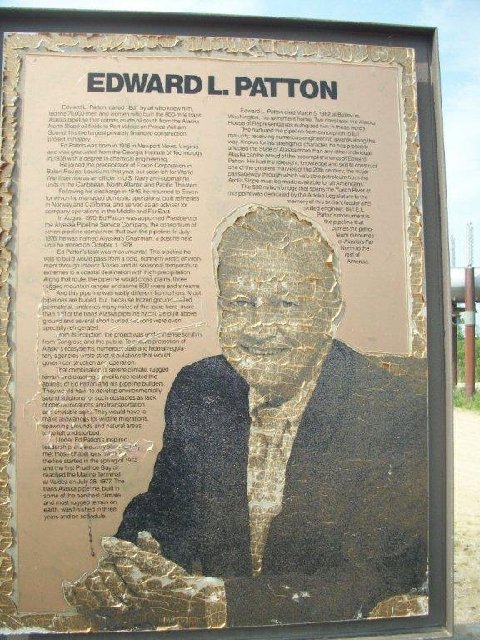
Above: Edward L. Patton. Chief Engineer. Trans Alaska Pipeline.
Storyboard at BLM Exhibit. Haul Road and Yukon River. 2010.
Addendum:
Second canal will lose money I doubt it will be built.
Burning Man,
Reno, NV
Steve
Margaret looks wonderful. Give her my best..
The Pope,
Naples, FL
Not the voyager. The mariner is name of ship.
TIMDT,
Regent Seven Seas Mariner
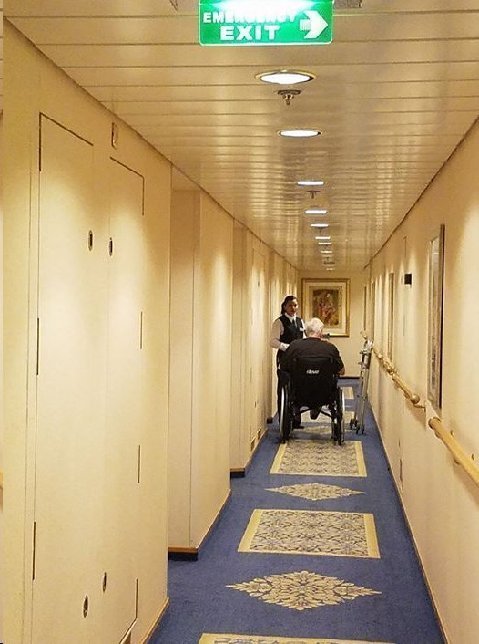
Above: Wheel chair bound Bishop and Penthouse "A" butler, Gayatri, from (now flood besieged) Mumbai. 22 September 2017.
Port side companionway, forward, 11th deck. Regent Seven Seas Mariner. Caribbean Sea.... in the wake of Hurricane Maria.
The wheel chair is more difficult to move on the carpets. I can hardly do it on my own. The tireless TIMDT can get it going OK. She seems not to mind pushing... says that it is good exercise.
From forward, where Gayatri and I are pictured, we negotiate the carpets to the elevator vestibule, then, we cross to the restaurants aft, on the wood pool deck where the pushing is much easier. We use the elevators at either end of the ship to get to the right deck.
Exiting to the pool deck is difficult when we are on our own, because, we have to open doors, and keep them open, while wheeling the chair backward, over a threshold hump. More often than not, however, there is someone nearby always eager to help by keeping the door open.
I'm pretty much self sufficient in our cabin now. I can shower on my own, dress on my own, and do the bathroom drill, and toilette on my own. I have used the walker throughout. The only use of the crutches, so far, has been on the aircraft, between getting off the wheelchair in the jetway and moving to the seat on the plane... the walker is too big and unwieldy to negotiate that passage.
I have four spots in the cabin where I reside during the day. The desk, where my computer is located, the divan, across the cabin from the desk, the right side of the king size bed, and the chair on the outdoor deck, when weather permits.
Moving from place to place I carry my phone, the TV remote in my shirt and shorts pocket, and the book I'm reading, between my teeth.
TIMDT seems gratified that she is needed less and less for the assistance that I seemed to require earlier. I continue to depend on TIMDT getting my clothes to wear and pushing me around on the ship.
With our butler service (see butler Gayatri in the image) everything is pretty much at your beck and call. Ice for the leg? Comes in two big plastic bags within five minutes of a request. For icing sessions, I recline on the divan and use narrow divan pillows, leaned against the back of the divan, to elevate my leg.
The leg seems to get better from day to day. There is still a minor amount of swelling, when I'm upright, that occurs below the knee. The swelling problem, though, seems to lessen day by day.
Three times we have eaten in the room. Room service sets up a white table cloth dining experience on the table by the divan. When I eat in the room, I usually default to comfort food... a burger and fries or spaghetti Bolognese.
While it is too early to pat ourselves on the back for taking this cruise given my condition, the benefits, so far, seem to outweigh the difficulties. Though TIMDT has had to work hard to see to my movements, she has benefited from not having to prepare meals or keep up our living space. She has had time to join Montage and SpaGo on the central American shore excursions and go to lectures or exercise classes.
Seeing the 'bucket list" Panama Canal was a home run. The hired car and guide stop at Cartagena, with me exiting the ship and joining the sightseeing, worked well and served as a great introduction to Colombia for our first time visit there.
Each day, the vista out of the cabin window is new.... one could argue that a new daily scene alone is superior to having to look out of our bedroom window day after day during the recovery period. To top that off, we've missed, happily, Park City's early season snow... good if you're anticipating the ski season... but, not so good if you are recovering from broken leg surgery.
If an argument to go on a trip like this, considering my condition, was to make the time pass more quickly... well, that has worked to a tee.
Knock on wood. We have a hurricane to bypass and have to negotiate the transfer from the port in New York City, to JFK, to a four hour flight, and then home... but, so far, the trip has been a great experience.
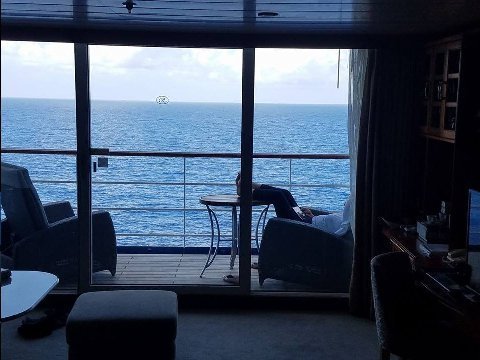
Above: TIMDT. Caribbean Sea. Regent Seven Seas Mariner. 22 September 2017.
Relaxing on cabin deck, at Sea.
Making way, cranking at 21 knots, towards the Windward Passage (between Cuba and Haiti).
BISHOP UPDATE: 8:00 AM EST 24 SEPTEMBER 2017
Overnight we (Regent Seven Seas Mariner) headed almost due west to get out of the Maria induced chop. We are now ten miles or so south of Freeport, Bahamas, entering the Florida Straits. Calm Waters! We were rockin' heavily last night when we were further east. West Palm Beach is due west from us, about eighty miles.
Since we did not stop at Nassau, we have ten hours of slack. Cap'n strategy is to head north from here, bypass the storm on its west side... still expected to be about 220 miles to the east when we go by. Chop, Cap'n forecasts, will be there, but, hopefully, since we have delayed our passage north by this westward veer, the storm will have weakened in the colder waters.
Problematical, though is that Maria is a very slow moving hurricane. Five MPH. It might not be far enough north, hence stronger, when we have to pass it.
If we're going to get to NYC on AM of 27th, we're going to have to overtake the storm. If she trends, as expected to the NNE, we'll be fine. If she veers to the NW, beeline on NYC, we may be planning a new way home.... from Charleston.
CAP'N UPDATE 5:00 PM EST.
Mid course correction #2. We're now going further west, up through the Florida Straits. Beeline north via Bahamas, original plan, choppier than expected. 15 foot swells. New route means more time, more distance, smoother sailing, but delay getting by Maria, expected to be 220 miles east of us when we pass her. That's OK because we have extra time by skipping The stop in Nassau. The further north Maria gets, the more she weakens. If she trends unexpectedly too far northwest, all bets are off. We could end up in Miami or Charleston. Otherwise, pass her to the west and beeline to NYC. Rockin' and Rollin' now.
CAP'N UPDATE NOON EST.
Sunday 10 hour stop Nassau cancelled. Maria trending NNW closer to east coast. Must get around it, and ahead of it, staying 200 miles to the west of the storm.
This is 2nd time on this cruise that hurricane dodging has eliminated a cruise stop. First time over a week ago. Missing Acapulco to dodge hurricane Max.
9:00 AM EST:
Regent Seven Seas Mariner is 25 miles north of eastern Cuba heading for Nassau, Bahamas at robust 18 knots. Nassau arrival Sun AM.
Rocking and rolling on 15 foot swells.
Cap'n says he'll leave earlier than planned from Nassau direction NYC on Sun eve and chart a longer course to the west, closer to the US coastline.
As of now...that is.
We're still not outta the woods.
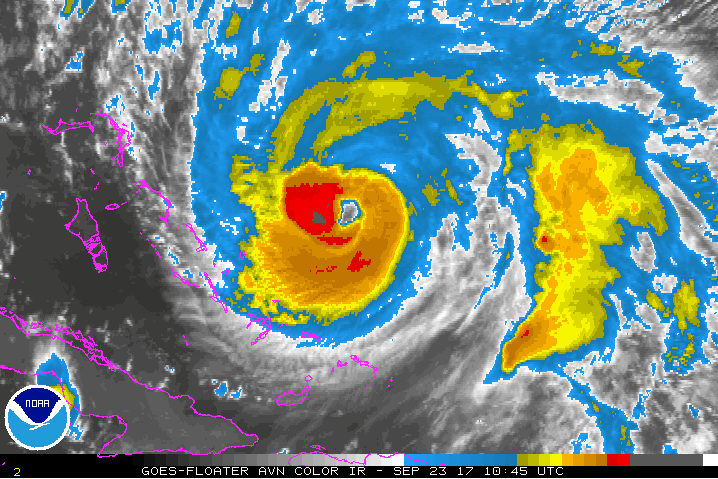
Bryan Norcross
Saturday update: HURRICANE MARIA has finally left the Caribbean Islands and the Bahamas behind and is heading north into the coastal water off the Southeast U.S., leaving behind a stunning path of destruction and tragedy in Puerto Rico, the Virgin Islands, Dominica, and the other islands it touched.
Maria is no threat to Florida and Georgia.
The latest model trends continue to show that Maria might come uncomfortably close to the North Carolina coast the middle of next week. Odds still favor that the worst of the storm will stay offshore, but that continues to be less than a 100% certainty.
Maria is expected to slowly weaken as it moves north toward cooler water – made extra cool when Hurricane Jose trod the same patch of ocean last weekend, stirring up the cold water below the surface. In addition, upper level winds will, on average, become less favorable. At the same time, Maria is expected to grow somewhat larger, so its strong winds spread a bit farther from the storm’s center.
Maria’s path will be guided by a variety of weather systems. Currently, the path north is around the western end of the large high-pressure system, which is spread across the Atlantic. As it reaches Florida’s latitude, the remnants of Jose might deflect it a bit to the east away from land. But Jose is dying, so the high-pressure system that trapped Jose will have a chance to take over and direct Maria a bit closer to the North Carolina coast around midweek.
Maria may slow down briefly in the general vicinity of Cape Hatteras or the Virginia coast before a strong dip in the jet stream comes along that should pick up the storm and fling it out to sea by late week.
We can’t know exactly how strong these various influences are going to be and their timing, so we can’t be precisely sure of the impact on the coast. The highest threat would seem to be in North Carolina, Virginia, and the Delmarva Peninsula, with some fringe effect on the Jersey Shore, but timing is everything. A change in Maria’s forward speed would change exactly where the hurricane zigs and zags.
Strong swells causing dangerous beach conditions will reach the Southeast and Mid-Atlantic Coast well in advance of the bad weather, and the hazard will continue even after Maria moves away.
The low-pressure system that was JOSE is dying and limping away from the Northeast. Some minor residual effects continue in the agitated ocean, but for all practical purposes, Jose is dead.
Here are the KEY MESSAGES on HURRICANE MARIA from the National Hurricane Center:
1. Swells from Maria are expected to increase along the coast of the southeastern United States and will likely cause dangerous surf and life-threatening rip currents for the next several days.
2. Maria will likely move between the east coast of the United States and Bermuda by the middle of next week. While the forecast track has moved closer to the U. S. east coast, it is still too soon to determine what, if any, direct impacts there might be in these areas.
3. For more information on the flooding and rip current hazards in the United States, please monitor information from your local National Weather Service forecast office atwww.weather.gov.
Above: Bryan Norcross report on Hurricane Maria, and Bishop Commentary, 23 September 2017.
10:30 AM EST. SUNDAY -
Seven Seas Mariner, northbound at 21 knots (full speed) in Florida Straits 85 miles east of Jupiter, Martin County.
Await Cap'n report, but we have to squeeze through the gap between Hatteras and Maria to get to NYC by 27th AM.
Interesting conundrum: how much risk to take in order to stay on schedule? Breaking schedule means disrupting the next cruise where NYC passengers will be unable to leave as expected.
Stay tuned.
PS. Norcross talked US through Andrew 25 years ago. Never expected to depend on his reports a second time.
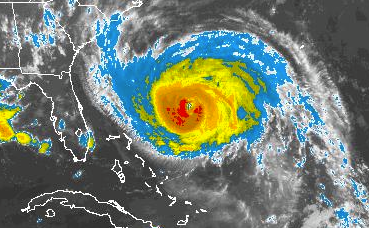
Bryan Norcross added 2 new photos.
23 hrs ·
Sunday update: HURRICANE MARIA is on track for a close brush with eastern North Carolina and the southern part of the Mid-Atlantic coast midweek. Winds will increase in North Carolina on Tuesday and spread north to eastern Virginia and the Delmarva Tuesday night into Wednesday. Odds slightly favor the worst of Maria’s winds staying offshore, but damaging winds are increasingly likely.
Maria is forecast to continue weakening, but is still expected to be a hurricane when it arrives in the coastal waters of North Carolina. The storm has grown larger – the eye is now about 35 miles across and the winds over 40 mph extend out nearly 200 miles on the west side of the storm, increasing the likelihood of the strong winds extending inland.
A notable aspect to this storm is going to be its slow motion – meaning the winds will seem to relentlessly blow off the ocean – when it tracks near North Carolina. Strong east to northeast winds are going to persist for two days or more on the Outer Banks and a good part of that time in the Tidewater of Virginia and the Delmarva. Persistent strong winds loosen trees and power poles and are more likely to cause outages, as we saw in Irma in South Florida.
The steering continues to be subtle and complex. Currently Maria is being steered north around the west end of the Atlantic high-pressure system into a gap cause by former-hurricane Jose. Jose is gone, but a slight weakness in the high persists. By Tuesday, however, the gap will fill and a Canadian high, which trapped Jose off the north coast last week, will briefly control the steering, pushing Maria toward the coast and slowing it down – much like Jose was affected off New England. The high keeps Maria near or over eastern North Carolina through much of Thursday when a dip in the jet stream comes along to scoop up Maria and fling it out into the Atlantic.
The precise strength and, therefore, influence of these weather systems is impossible to know, which adds uncertainty to the forecast. In addition, because the strongest winds will still be concentrated near the center of Maria, a slight jog one way or other will make a big difference in the strength of the winds at the coast.
Hurricane or Tropical Storm Watches are likely along the coast. Be ready for a long-duration wind event on the Outer Banks, the Sounds, and nearby areas.
Here are the KEY MESSAGES from the National Hurricane Center at 5:00 am ET:
1. Maria's forecast track continues to be northward, paralleling the U.S. east coast, and it is likely that some direct impacts will occur along portions of the coast next week. Interests along the coast of the Carolinas and the Mid-Atlantic should monitor the progress of Maria, as tropical storm or hurricane watches may be needed for part of this area later today.
2. Swells from Maria are increasing along the coast of the southeastern United States and are expected to reach the Mid-Atlantic coast today. These swells will likely cause dangerous surf and rip currents at the beach through much of next week. For more information, please monitor information from your local National Weather Service office at www.weather.gov.
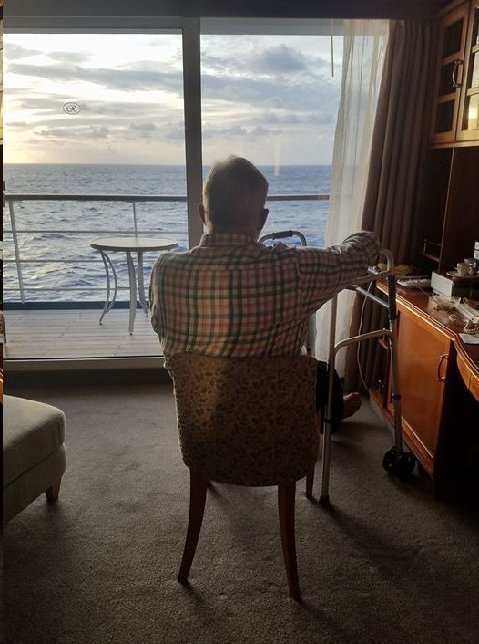
Above: Bishop. 24 September 2017.
Waiting to leave for dinner. Cabin 1104. Forward. Regent Seven Seas Mariner.
150 miles off central Florida east coast, proceeding north at 18 knots.
Swells don't look it, but they're 12 feet.
Ship is bouncing along as it positions to overtake Hurricane Maria, 200 miles to the east, in a feint to the west, early tomorrow morning.
Yucky seas, spawned by Hurricane Maria, expected all the way to NYC where arrival is scheduled for 7:00 AM, 27 September 2017.
Monday AM. 25 September 2017.
Regent Seven Seas Mariner is racing into the squeeze between North Carolina's outer banks and the outer rim of Hurricane Maria.
Cap'n's strategy to out run the storm on its west side seems to be working OK. BUT....seas are very heavy, with 18 foot swells and 60 knot apparent winds. Life on board ship is not very comfortable, with the prospect of respite soon, negligible.
Reclining...snoozing...reading...TV...is the best strategy.
Storm is weakening and is not expected to be a risk for the US northeast.
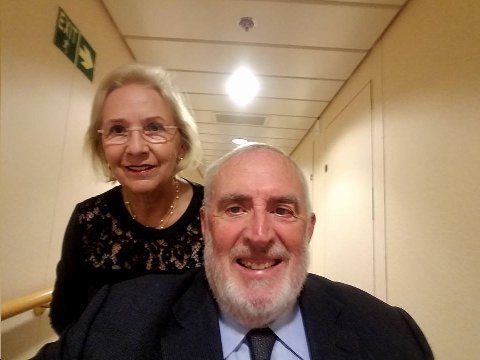
Above: TIMDT and Bishop. TIMDT's 39th. Regent Seven Seas Mariner. 25 September 2017.
Ship is northeast of NC Outer Banks, having outraced Maria, heading to the same spot. Cap'n has announced an early arrival in NYC, 26 September 2017, at 4:00 PM (as opposed to next morning, 27th, at 7:00 AM.
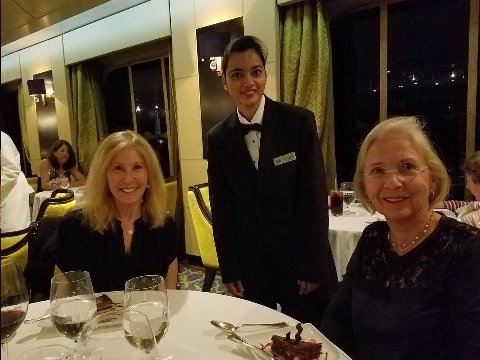
Above: TIMDT and birthday cake. Signature Restaurant. Birthday dinner. Regent Seven Seas Voyager. 25 September 2017.
Cake hat tip: SpaGo.

Above: SpaGo, Gayatri (butler), TIMDT. Regent Seven Seas Voyager. Birthday dinner. 25 September 2017.
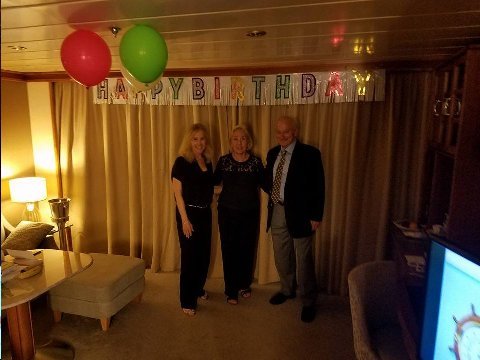
Above: Spago, TIMDT, Montage. Our cabin. Regent Seven Seas Voyager.
Ship's crews' decorations for TIMDT birthday.
Addendum:

Above: Snow. Deer Valley. 25 September 2017.
Skipping autumn?


Above: Peterbuilt images at Alta. 25 September 2017.
Hello Taylors: It snows one day and melts the next. Rinse and repeat.
We are furnishing some hauling equipment to erect a new lift at Alta. Image taken 9/24/17. I'm sure healing is better at lower latitudes with good cruise ship food.
Peterbilt,
Salt Lake City, UT

Poor picture due to sun direction..
Funky car left running outside a market; windows opaque with slobber;
Three massive newfies inside
Enjoy your trip
ASPCA, Larkspur, CA
I have some interesting ancestral history with the Panama Canal on my mother's side of the family. In December 1886 my great great grandfather Jose Dolores Rodriguez was the Ambassador to the USA from the newly formed "Greater Republic of Central America," which was a short lived political union of Honduras, Nicaragua, and El Salvador (June 1885 - November 1898*). J. D. Rodriguez whose family dates back to Nicaragua starting in the 1500s, was received by President Cleveland and Secretary of State Olney in December 1896. At that time the USA was planning to build an inter oceanic canal through Nicaragua. On January 15, 1897 J. D. Rodriguez strongly objected to the proposal on the grounds of various provisions unfair to Nicaragua. The USA dropped their plans and years later finished the canal that the French had started in Panama. Interesting enough there currently is a Chinese consortium that negotiated a deal with Ortega in 2014 to build a new canal through Nicaragua. Due to financial troubles by the leaders of the consortium, odds are that this canal will not be built. The Greater Republic of Central America was dissolved in November 1898 when General Thomas Regaled seized power in El Salvador.
Nathans, Massapequa, NY
Fascinatin' (sic)!
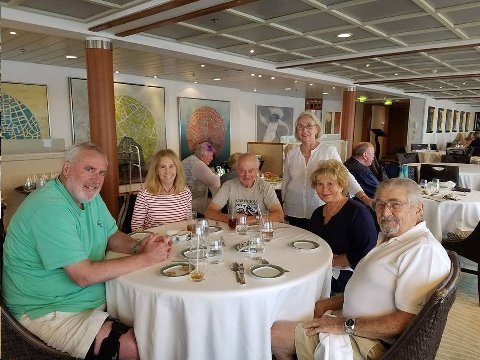
Above: Bishop, SpaGo, Montage, TIMDT, Barbara Wayne. Veranda Restaurant. Regent Seven Seas Mariner. 26 September 2017.
Abelsons and Taylors learn from Taylor friend Carol that Parkite's Barbara and Wayne are also on the ship. We unite for a splendid lunch and hopes for a budding friendship!
We have some common connections. Barbara a twenty year friend of Beano... and while I don't know Beano well, I am aware of her philanthropic efforts in Park City. I am also a motorcycling buddy with Beano's brother, The Zookeeper, who lives in Williamstown, MA (who also has a comment in the Addendum of this Picto Diary).
Barbara, a bridge player, knows ZIB.
Small world phenomenon never ceases to amaze.
Hat tip to Carol for facilitating our pleasant lunch.
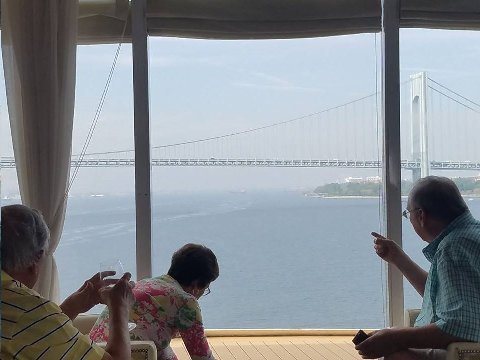
Above: Verrazano Narrows Bridge. New York City, NY. 26 September 2017.
Image from observation lounge, Regent Seven Seas Voyager.
Returning to my home town. One of them, anyway. Lived for four years in the NYC area.
51/52 Bayside Queens. Dad getting PhD from NYU.
88/91 Westport, CT. Employment with Citibank.
The entrance to New York Harbor via the Regent Seven Seas Mariner proved to be a momentous cruise experience.
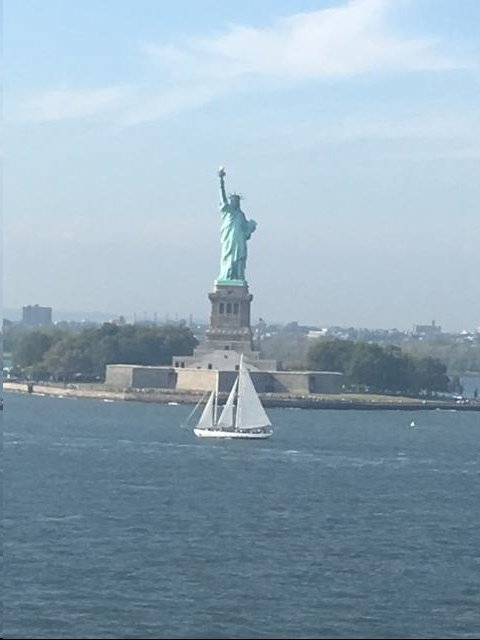
Above: Statue of Liberty. New York Harbor. 26 September 2017.
Image by TIMDT form our cabin deck, Regent Seven Seas Mariner.
Sailing by the beautiful lady was a moving experience. A stream of immigrants have entered the US via this same route. My own forebears came from Europe... but, most of them entered the United States at the Port of New Orleans in the 1850's, traveled by steamboat up to Omaha, and traveled west in the Mormon migration to Utah.
As a First Grader, in 1951, I walked up to the torch of the Statue of Liberty. Narrow spiral staircase up the inside of the arm. You can't do that any more.
I still remember doing a show and tell about my stature visit at PS 31, Bayside Queens. I was shocked when the teacher asked fellow students to raise their hands if they had visited the Statue of Liberty.
None had. I was young... but, old enough to be surprised at the irony of me being more of a visitor/transient in the city having visited an important NYC land mark, when native NY kids hadn't.
During the '80's we visited Ellis Island and the Statue of Liberty as a family. I've taken the Staten Island Ferry more than a couple of times. All these memories were brought to top of mine as the Regent Seven Seas Voyager sailed into New York Harbor.
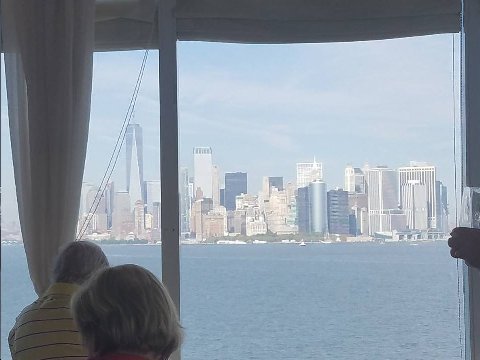
Above: Downtown Manhattan. New York, NY. 26 September 2017.
Image taken by Bishop from observation lounge, Regent Seven Seas Voyager.
The image of The Freedom Tower, where the Twin Towers once were, is sobering.
While visiting NYC last October, Hoops and Mwah (sic) visited Lower Manhattan and the Freedom Tower site.
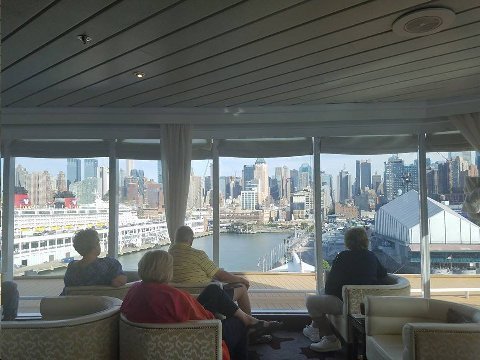
Above: Ship Terminal. New York City, NY. 26 September 2017.
Image taken by Bishop from observation lounge, Regent Seven Seas Voyager.
I never tire of watching a ship's crew ease a big ship into its berth.
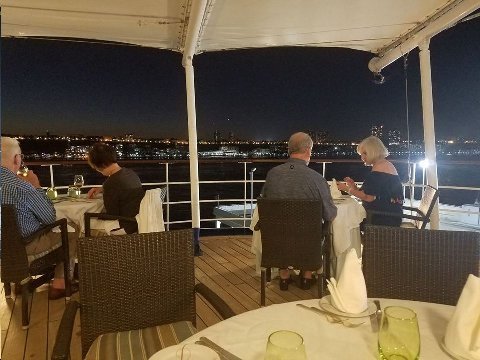
Above: Sette Maria Restaurant. Ship Terminal. Regent Seven Seas Voyager. 26 September 2017.
Image captured by Mwah (sic) from our dinner table overlooks Hudson River.
Don't try to find this restaurant on the Hudson. It moves from place to place. Last time we dined there was in Cartagena, Colombia, five days ago.
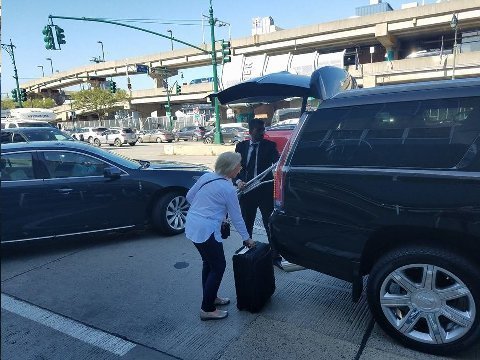
Above: TIMDT helps load SUV transport to JFK outside of the ship terminal, 49th Street and 12th Avenue. New York, NY. 27 September 2017.
All immobilized Bishop can do is take an image. Bishop shudders as he contemplates the day when TIMDT demands payback.
Looking back, we made the right decision to come on this cruise.
The time has passed quickly and I have enjoyed the experience notwithstanding my impaired mobility. The Panama Canal and New York Harbor, both bucket list experiences, could be enjoyed without getting off the ship. The day trip to Cartagena, my first visit to Colombia, was excellent. We enjoyed fine dining meals and pleasant social interaction with our friends.
I remember how uncertain I felt when, three weeks before the cruise, TIMDT insisted that we would be going, notwithstanding my infirmity (tibia plateau fracture; no weight bearing on right leg). We had paid for the cruise and had no trip insurance. Still, I was OK with writing off the payment as traipsing around airports and cruise terminals with one gimpy leg seemed to be an obstacle too much to overcome.
TIMDT's resourcefulness and effort in making the trip happen, considering my tentative attitude and the large number of special planning steps required, is nothing short of amazing.
She organized all of the equipment... walker, wheel chair, crutches. She set up all of the transfer arrangements at airport and cruise terminals, and squired me all over the ship to restaurants and lounges during the voyage.
Kudos TIMDT.
Addendum:
Hey Mr. Mariner,
I wanted to contribute my birthday wishes to TIMDT. It goes without saying that Margaret is looking lovely, but you also clean up good. I don’t think I’ve ever seen you so shiny.
May fair winds and following seas speed you to New York.
Cheers,
Mrs. Driggs,
Promentory, UT
Margaret looks beautiful. Same can't be said for her traveling companion.
I assume you read The Path Between the Seas by David McCullough before you left on this cruise. If not, it's not too late. It is, I think, the definitive book on the building of the Panama Canal.
Zookeeper,
Williamstown, MA
I tried to get a hard copy just before I left. Failed. Don't like reading from tablets... though, TIMDT put it on her tablet for me. I'll definitely get a copy and read it on return.